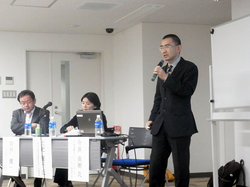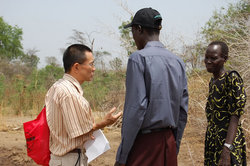* This report was made open to the public on the JVC’s Japanese web site in July, 2014, and had received many accesses in the fiscal year of 2015, when the argument about security legislation became most heated in Japan;
[Original by Takaki IMAI, Sudan Project (July 11, 2014); Translated by S. Thapa]

On 1st July, 2014, the Japanese cabinet made a decision to approve the use of force overseas in the name of the right of collective self-defense.
The Prime Minister of Japan refers to “kaketsuke-keigo” as one of reasons why the right of collective self-defense will be used. It means that when a NGO’s staff like me who is assigned to work in a place of conflict, is attacked by “armed militants”, the Self-Defense Forces will come to help me.
In this regard, I wrote a draft report for newspaper articles, but it was not printed because it was too long (laughing!). Instead of keeping it unpublished, I decided to convey it to the readers of my “local report”.

As I am living in Africa, very remote from Japan, I am getting less familiar with its current news. However, when I acknowledged the current movement about the right of collective self-defense, especially Prime Minister Abe’s suggestion of “kaketsuke-keigo for the Japanese NGO working there” as one of the reasons why the Self-Defense Forces will be sent overseas, I cannot help having strong astonishment and feeling that something was wrong.
As a member of the staff in an international cooperation NGO, Japan International Volunteer Center (JVC), I have been residing in South Sudan (at that time Southern Sudan Autonomous Region) and Sudan for seven years, and engaged in local human relief activities. During this period, I happened to come across military conflicts in Kadugli City, South Kordofan State, Sudan, in June, 2011, and experienced emergency evacuation from street fighting together with UN staff. Additionally, I was informed that local people including our former staff were involved in a civil war which happened to occur in South Sudan. According to this experience, I have a frank impression on “kaketsuke-keigo”: How we could manage to do it?
In the chart, which Prime Minister presented at the press conference, the composition was designed to everyone’s easy understanding based on a very clear philosophy of good and evil, by showing that a group of “terrorists”-like armed militants, attacked Japanese NGO’s and UN’s staff and then the Self-Defense Forces came and helped them. However, the real scene of modern conflicts could not be as simple as that chart.
During my emergency evacuation, the situation was such that the government forces and anti-government ones were mobilizing local militias respectively, and that battles were fought without clear distinction between official soldiers and unofficial ones. There was no distinctive chain of command in the forces, and while they were fighting in a city “soldiers” broke into shops and homes and destroyed and looted them as well as searching for “enemies”. Although it was not known clearly who did such destruction and looting, the danger was approaching closer to NGO and UN facilities.
We were exchanging communication with each other and waiting for the rescue forces to be sent by UN PKOs, which were deployed in the suburbs of the city. However, PKOs hesitated to send its forces, because they were afraid they would be involved in fighting. Finally, UN decided to dispatch an unarmed rescue team, not armies, into the city, and then we were safely evacuated to the UN’s facilities in the suburbs in a line of white 4WD cars. This means that the rescue work by unarmed vehicles succeeded.
Last December, there was an incident where fighting had occurred in the city of Juba, South Sudan, where the Japanese PKOs were stationed.
At that time, the state army of South Sudan was split into two groups: “the state army” supporting the President, and “the anti-government forces” opposing it. Furthermore, various groups including armed local residents were mixed therein, and they were not only fighting each other, but also attacking civilians and destroying residences by targeting specific ethnic groups. However, under confused conditions that persons in charge of mutual fighting or attacking civilians at a specific place could not be defined as a member of “the state army”, “the anti-government forces”, or the militias, UN PKOs would not “come to help” in the scene of fighting. PKOs avoided direct involvement in fighting, and limited their function to protecting local residents who had taken refuge in the PKOs facilities.
At the scene of fighting, there were various different forces including armed local residents who were repeatedly changing sides, causing occasional “betrayal”. This made it difficult to distinguish between allies and enemies. How could we really imagine that the Japanese Self-Defense Forces could “come to help”, without being involved in fighting? How could they distinguish between “armed forces” and “residents with guns in their hands”? It would be possible that an opponent, when fighting, was wearing military clothing of the state official armies. We will have to accept the reality that even UN PKOs were most prudent to take rescue operations when fighting was going on.
Nevertheless, there is actually a country which would like to intervene with military powers.
As to fighting in South Sudan, Uganda, its neighboring country, dispatched their forces by claiming to “rescue Ugandans living there”. Thereafter, they became a party concerned in fighting as an ally of “the state army”, and started to attack “the anti-government forces”. This incident raised strong hostility against Ugandans among people supporting “the anti-government forces”. In some areas, local residents started to attack Ugandans living there, many Ugandans sought for protection in the UN’s facilities. Contrary to their efforts to “rescue countrymen”, their actions caused the countrymen to be exposed to risk. Consequently, many Ugandans came to rely on the neutral UN, not their own country’s army.
Because the Ugandan army apparently supported “the state army”, this could be considered as an extreme case. But it would be fully possible that, once the Self-Defense Forces took an action in fighting area “due to consent a counterpart country”, ordinary civilians would understand “they came to support the state army”.
There are some people locally who have strong antipathy against some American or European countries which have made military intervention in conflicts in Africa so far. Occasionally, it could be escalated to incidents like attacking and kidnapping Americans or Europeans.
Unlike America and some European countries, the feeling of local people about Japan is generally far better, because it has not dispatched any armies yet. Also in Sudan, their feelings about Japan is friendly, because Japan is famous for not having intervened militarily or politically but having done assistance activities in the field of water supply, medical treatment, and job training.
If the overseas development of the Self-Defense Forces was strengthened by introducing a reason actually lacking in reality, that is “kaketsuke-keigo”, it would overrule the image of peaceful Japan fostered so far. We cannot help fearing that our safety in living overseas would be threatened rather than “protected” by it.
Share This: